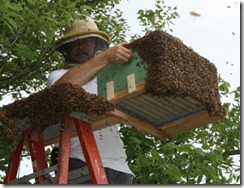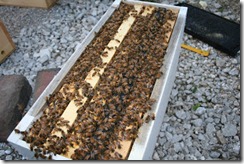
We enjoy beekeeping so much. Every part of it is thoroughly enjoyable, even when I’m high atop a ladder carrying down a swarm from a tree barehanded. I’ve done about everything there is to do with bees and it really gets in your blood. It’s a hoot. We love bees.
Hi, thanks for stopping in on our website and learning more about beekeeping. Every where we go people will see the signs on our truck and ask me about bees. Most people tell me that they’ve always wanted to keep bees or that their dad or grandpa kept bees and now they’d like to keep bees too. It is amazing how many people are becoming beekeepers.

We are David and Sheri Burns and together, with many of our family members, we operate Long Lane Honey Bee Farms, a family beekeeping business dedicated to encourage, assist and educate others in the wonderful experience of keeping honeybees. We’re kind of like the Duck Dynasty people but without the beards, dynasty and ducks. We are the one stop beekeeping shop, providing classes, beekeeping supplies, and even the bees for those who are getting started in keeping honeybees. Perhaps you will be the next one to start.
Today, I want to share several important uses of a 5 frame nuc box. But before I do, let me share 3 things: 1) We have added a third
basic beginners class on March 30th. We are also offering classes on March 9th and 23rd, but these classes only have a few openings, so we’ve added March 30th. These classes are all on Saturday from 9am – around 3:30 central time. They are held in our new beekeeping education center. It’s very comfortable and right here on the bee farm.
Click here to read more about our beekeeping classes. Since there are many places to take beekeeping classes, we have detailed information as to what you’ll receive from taking one of our classes. Just click on
Why Take Our Beekeeping Class
Secondly, we are offering
$30 Off Our Completely Assembled & Painted Hive. Complete with screen bottom board, two deep hive bodies, 20 wooden deep frames and foundation, one super with 10 wooden super frames and foundation, inner cover and top cover, queen excluder and feeder!
This offer is only good through midnight Sunday, February 17th, 2013.
Thirdly, we are only weeks away from the publication of our E-book on Beekeeping. It’s in its final editing and formatting stage. We are excited about this project and it has bee 5 years in the making. We will keep you posted on when this book will make is debut. This book is a collection of years of working with bees, research and 20 years of beekeeping experience. The book is around 300 pages long with very good pictures.
Lesson 133: Using A 5 Frame Nuc To Support A Hive

Today I want to share why it is helpful to own a 5 frame nuc. We use the word nuc because it is short for nucleus, which means a smaller part of a larger hive. For years, I have been promoting the importance of using a small 5 frame nuc box as a smaller, support hive for a larger hive. So let me start here with the idea of using a small nuc to support a full size hive. How does this work? Here is an easy way to do it. From a full size hive remove 3 or 4 frames in the spring. Make sure you move frames over to the nuc that contain honey, pollen, brood and eggs. The nuc will raise a new queen from the frame of eggs. This will take about three weeks before you have a laying queen, so just be patient. If you move over 3 frames from your larger hive, use two new frames as this will allow the bees to build comb out on the new frames.

In three or four weeks, you’ll have a fully operational hive on five frames in your nuc box. The primary help offered by your nuc is that if something ever happens to the queen in your larger hive, you can move the queen from your nuc box into your queenless hive. You will, of course, need to place your nuc queen in a queen cage with a marshmallow covering the opening hole. This will allow the queenless, larger hive time to become familiar with the new queen while they are releasing her by consuming the marshmallow candy. Your nuc will be queenless only a short time because they will immediately start raising a new queen. The reason this is so valuable is because you’ll have access to replace your queen immediately once you discover your larger hive is queenless. And your queen will be a local queen from your area. Often it can take a week or two to order and receive a queen. Since a queen lays 1,000-3,000 eggs a day, the longer you wait for a queen, the less populated your hive becomes. If you wait 14 days for a queen, you will lose 21,000 future bees (1,500 eggs x 14 days). That is equal to two 3 lb packages of bees. $200 worth of bees. This is especially important because many beekeepers fail to take their hive into winter with a good queen or even a queen at all. This causes the overwintering population of bees to be too low to keep warm, and the hive perishes in the winter with plenty of honey. They simply did not have the full count of bees to keep the hive warm, because of a queen issue.
Click here to order our 5 frame nuc.Another way a 5 frame nuc can be helpful is because it has frames of resources that at any time can be transferred over to a weaker hive. If a larger hive is running short of pollen or honey, a frame can be transferred from the nuc. Or if a weak hive needs a shot in the arm of brood, a frame of brood can be move over.
The 5 frame nucs can be placed anywhere even behind the support hive. In a good year, the smaller nuc must be inspected often. Since there are only 5 frames, you may have to pull out a frame of honey and share it with a weak hive or extract it and fill a couple of jars. Also, it is fun inspecting the smaller nucs because there are only 5 frames which means it is easier to inspect with only 5 frames. In fact, I think learning to work bees on a 5 frame nuc is always a great way to start. You can use your 5 frame nuc to mentor potential beekeepers. We are often asked to speak at schools and we use a single frame observation hive to take to class. We always go to one of our nucs to pull a frame because with only 5 frames it is easier to find the frame the queen is on. A large hive has 20 brood frames and 10-30 honey frames.
It is also a good idea to have an empty 5 frame nuc available to take to capture a swarm or to move frames out of a hive that is so large it might swarm unless you make a split. Every beekeeper will benefit greatly from having a couple of 5 frame nucs ready to assist you in your beekeeping endeavors.
We use 5 frame nucs in our queen rearing operation. We are in full queen rearing operation by June and our field is sprinkled with hundreds of nuc boxes used as mating nucs and starter hives.
Now, I realize that someone might be thinking about using a 5 frame nuc as a hive all year. Here’s the challenge, it will grow and you’ll need to give them room to expand or they will swarm if they become congested. We do sell additional deep 5 frame boxes that are used to go above the bottom box. Can you make this a hive? Yes, the challenge will only be that you’ll need to add three or four boxes and a 5 frame nuc is only 9” wide. Our standard Langstroth hive is 16 1/4” wide. So the nuc only has a 9 x 20” base and if you stack 5 boxes on top, it could blow over. You will have to find a way to keep the 5 frame hive secure against the wind if you choose to add 3 or 4 additional boxes on top. One option is to use a tie down strap and secure it to a pallet or use two large tent pegs in the ground to secure your strap to and carry it over the top of the 5 frame hive. Other than this challenge, 5 frame hives work fine.

We make our 5 frame nucs exactly as we make our hives. We have a real, screen bottom board, a real inner cover and a real top cover with metal. It is just like a large hive only with 1/2 the number of frames and only 9” wide. Our 5 frame nucs come complete with 5 wooden frames and foundation which is helpful to have as your nuc grows. Our nucs are fully painted and assembled ready to go.
Click here to read our full product detail on our 5 frame nucs.Before we leave you let me invite you to look at our special hive kits that are available.

First, we've listened to our customers and so many wanted a kit where they could come and pick up their hive and bees and equipment and take a class while they were here all at the same time, the same day. So here it is. May 4th is the date to come and pick it all up and take the class. However, you must order this kit in advance. 1 Completely assembled and painted hive consists of two deep hive bodies, 1 medium super, screen bottom board, inner cover, top cover, 10 wooden frames with super foundation, 20 wooden frames with brood foundation. 1 Equipment special, hat, veil, smoker and a hive tool. 1 3 lb package of bees with queen. A four hour bee class May 4th. To order or to find out more information,
click here. We are calling this our
Valentine Special. But we also have many other kits available with bees or without bees. Some of our kits do not include bees because people choose to find bee more locally. To see our full catalog of hives, CLICK HERE or go to:
http://www.honeybeesonline.com/kitswo.html 
For a limited time we are offering our
Freedom Kit with bees included. This was extremely popular last season. It comes with two hives, all the equipment like hat/veil/smoker/hive tool/book/smoker fuel/gloves/queen excluder etc. The reason two hives are better than one is if one hive becomes weak, you can share resources between hives.
CLICK HERE to see more information on our Freedom Beekeeping Kit. Thanks for joining us today, and please feel free to read through all our lessons online or give us a call and we’ll be glad to answer any questions you might have. 217-427-2678 Visit us online at:
www.honeybeesonline.com










































.jpg)





0 comments:
welcome to my blog. please write some comment about this article ^_^